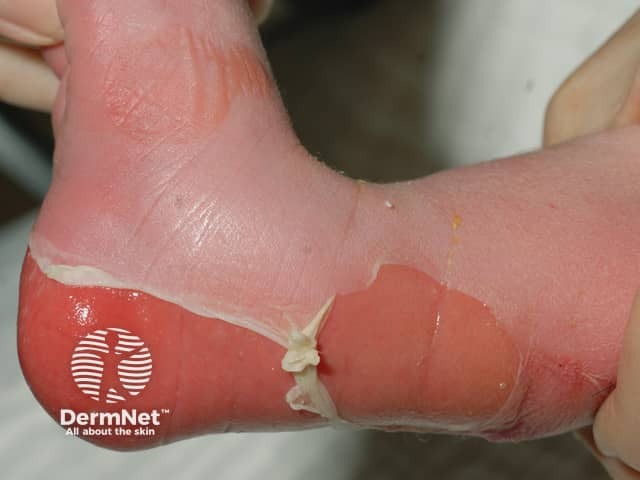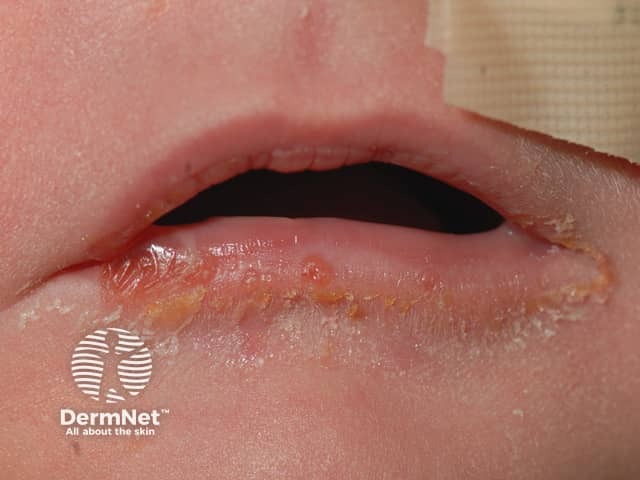Main menu
Common skin conditions

NEWS
Join DermNet PRO
Read more
Quick links
Dystrophic epidermolysis bullosa — extra information
Dystrophic epidermolysis bullosa
Author: Jane Widdowson et al, DEBRA New Zealand, February 2016. Minor update October 2023 and July 2024.
Introduction - epidermolysis bullosa
Introduction
Demographics
Causes
Clinical features
Diagnosis
Treatment
Outcome
What is epidermolysis bullosa?
Epidermolysis bullosa (EB) is a group of inherited diseases that are characterised by blistering lesions on the skin and mucous membranes. These may occur anywhere on the body but most commonly appear at sites of friction and minor trauma such as the feet and hands. In some subtypes, blisters may also occur on internal organs, such as the oesophagus, stomach and respiratory tract, without any apparent friction.
What is dystrophic epidermolysis bullosa?
Dystrophic epidermolysis bullosa (DEB) is characterised by the site of blister formation in the lamina densa within the basement membrane zone and the upper dermis. It causes generalised blistering of the skin and internal mucous membranes and leads to scar formation.
Who gets dystrophic epidermolysis bullosa?
Dystrophic epidermolysis bullosa is a rare inherited disease. There are two main subtypes: autosomal dominant dystrophic epidermolysis bullosa (DDEB) and autosomal recessive dystrophic epidermolysis bullosa (RDEB). The latter is the more severe form.
What is the cause of dystrophic epidermolysis bullosa?
Dominant dystrophic epidermolysis bullosa is caused by heterozygous mutation in the type VII collagen gene (COL7A1; 120120 ) on chromosome 3p21.
Recessive dystrophic epidermolysis bullosa is due to homozygous or compound heterozygous mutation in the gene encoding type VII collagen (COL7A1; 120120) on chromosome 3p21.
What are the clinical features of dystrophic epidermolysis bullosa?
DEB Subtypes |
Features |
|---|---|
Dominant generalised EB (DEB) |
|
Generalised severe recessive EB (RDEB) Previously known as Hallopeau-Siemens; and; Generalised intermediate RDEB (previously Non-Hallopeau-Siemens) |
|

Recessive dystrophic epidermolysis bullosa

Recessive dystrophic epidermolysis bullosa
How is dystrophic epidermolysis bullosa diagnosed?
In the dominant subtypes of epidermolysis bullosa, where an informative family tree is known, it is often acceptable for clinical diagnosis to be made by a specialist dermatologist based on the presenting signs.
- Diagnostic tests are also available in some countries and include skin biopsy of a newly induced blister which undergoes immunofluorescence antigen mapping (IFM) and/or transmission electron microscopy (EM). Mutational analysis (blood testing of genes), although not currently considered the first-line diagnostic test, is also available in some countries.
Squamous cell carcinoma in dystrophic epidermolysis bullosa is diagnosed by its clinical appearance and supported by biopsy.
What is the treatment of dystrophic epidermolysis bullosa?
See treatment of epidermolysis bullosa – general.
- Puritus (itching) may be a problem for patients with dystrophic epidermolysis bullosa — strategies such as moisturising and avoiding hot environments can help.
- Oleogel-S10, containing birch triterpenes or birch bark extract, has been shown to accelerate the healing of chronic wounds in junctional and dystrophic epidermolysis bullosa.
- In dominant dystrophic epidermolysis bullosa (DDEB), the focus is on blister prevention and management. This refers to the skin, but may also include eating soft foods to reduce oesophageal blisters.
- In severe recessive dystrophic epidermolysis bullosa (RDEB), high attention to both the skin and mucous membranes is necessary. Management of pain, pruritus, infection, scarring and deformities, malnutrition and anaemia all play a major part in the day to day treatment of RDEB.
- Trials for topical beremagene geperpavec (B-VEC) gene therapy have yielded some promising results for the treatment of cutaneous wounds in DEB.
- Squamous cell carcinomas are treated surgically. This should be done early, as the tumours are aggressive and have often metastasised by the time of diagnosis. Amputation may be required.
- There is promising pilot data for the treatment of RDEB with IV gentamicin as a nonsense variant readthrough therapy.
What is the outcome for patients with dystrophic epidermolysis bullosa?
Life expectancy is unaffected in dominant dystrophic epidermolysis bullosa. In recessive dystrophic epidermolysis bullosa, life expectancy has significantly improved due to appropriate management and interventions related to complications of the disease including the early detection and treatment of squamous cell carcinoma (SCC).
References
- OMIM – Online Mendelian Inheritance in Man (search term Epidermolysis bullosa)
- Epidermolysis Bullosa Simplex – GeneTests GeneReviews
- Dystrophic Epidermolysis Bullosa – GeneTests GeneReviews
- Dermatologic Clinics Volume 28, Issue 1, Pages 1-196 (January 2010) Epidermolysis Bullosa: Part I – Pathogenesis and Clinical Features
- Dermatologic Clinics Volume 28, Issue 2, Pages 197-452 (April 2010) Epidermolysis Bullosa: Part II – Diagnosis and Management
- El Hachem M, Zambruno G, Bourdon-Lanoy E, Ciasulli A, Buisson C, Hadj-Rabia S, Diociaiuti A, Gouveia CF, Hernández-Martín A, de Lucas Laguna R, Dolenc-Voljč M, Tadini G, Salvatori G, De Ranieri C, Leclerc-Mercier S, Bodemer C. Multicentre consensus recommendations for skin care in inherited epidermolysis bullosa. Orphanet J Rare Dis. 2014 May 20;9:76. doi: 10.1186/1750-1172-9-76. Review. PubMed PMID: 24884811; PubMed Central PMCID: PMC4110526.
- Fine JD, Bruckner-Tuderman L, Eady RA, Bauer EA, Bauer JW, Has C, Heagerty A, Hintner H, Hovnanian A, Jonkman MF, Leigh I, Marinkovich MP, Martinez AE, McGrath JA, Mellerio JE, Moss C, Murrell DF, Shimizu H, Uitto J, Woodley D, Zambruno G. Inherited epidermolysis bullosa: updated recommendations on diagnosis and classification. J Am Acad Dermatol. 2014 Jun;70(6):1103–26. doi: 10.1016/j.jaad.2014.01.903. Epub 2014 Mar 29. Review. PubMed PMID: 24690439.
- Doolan BJ, McGrath JA, Mellerio JE. Beremagene geperpavec (B-VEC) gene therapy for the treatment of cutaneous wounds in patients with dystrophic epidermolysis bullosa: a critically appraised research paper. Br J Dermatol. 2024;190(3):340-342. doi:10.1093/bjd/ljad433 Journal
On DermNet
- Epidermolysis bullosa
- Epidermolysis bullosa simplex
- Junctional epidermolysis bullosa
- Kindler syndrome
- Epidermolysis bullosa pruriginosa
- Epidermolysis bullosa acquisita
- Friction blisters
- Blistering diseases
- Prenatal testing of inherited skin disorders
Other websites
- EB-CLINET — a clinical network of EB centres and experts
- DEBRA International
- DebRA Dystrophic EB Research Association of New Zealand
- DebRA of America Inc.
- DEBRA UK
- Australasian Blistering Diseases Foundation: including guidelines for referring a biopsy for diagnosis at the National EB Diagnostic Lab in Australia
- Asociacion de Epidermiolisis Bulosa de Chile
- Epidermolysis bullosa — Medscape Reference
- Epidermolysis bullosa with pyloric atresia US National Library of Medicine Genetics Home Reference
- Dystrophic epidermolysis bullosa — US National Library of Medicine Genetics Home Reference
- Dystrophic Epidermolysis Bullosa — British Association of Dermatologists
- Epithelial Adhesion — geneSkin
- GeneTests — A medical genetics information resource.
